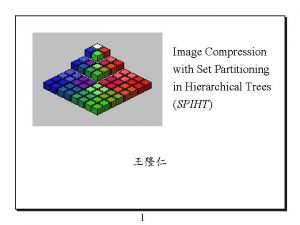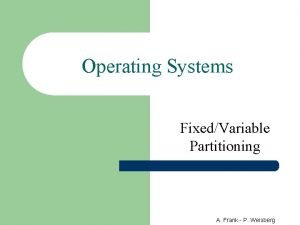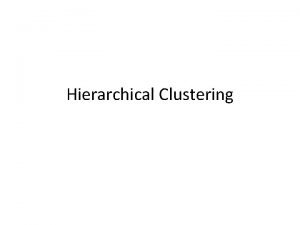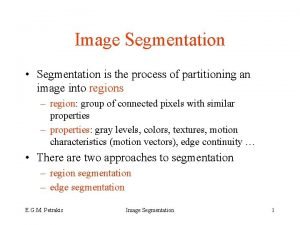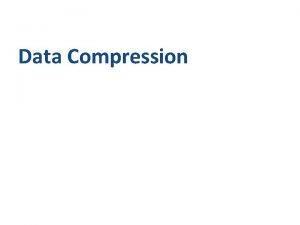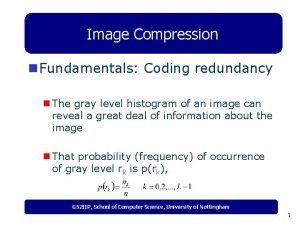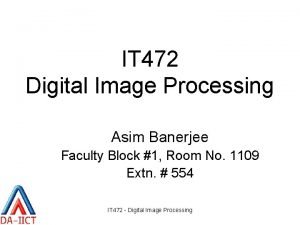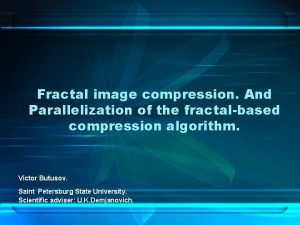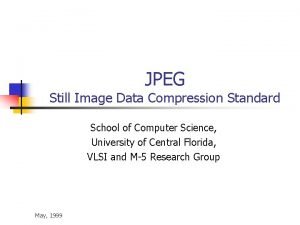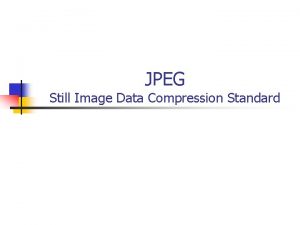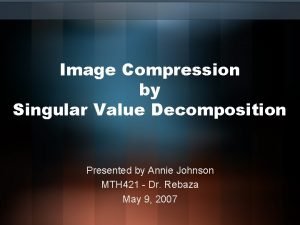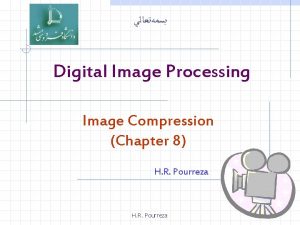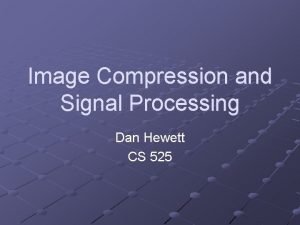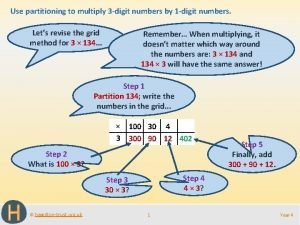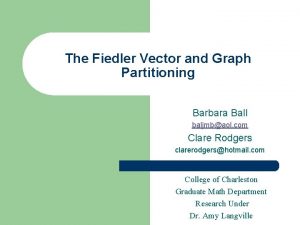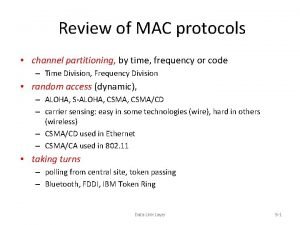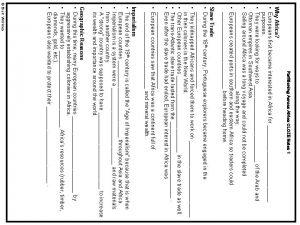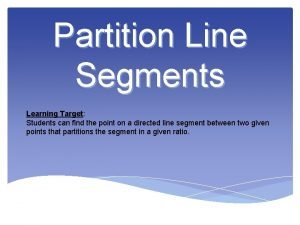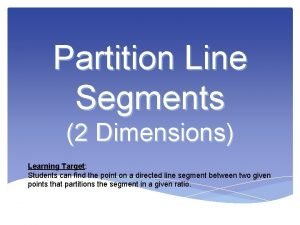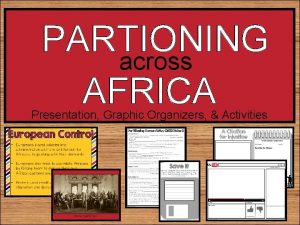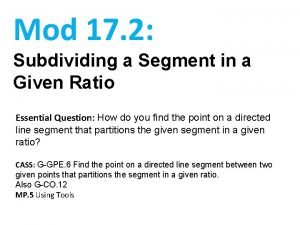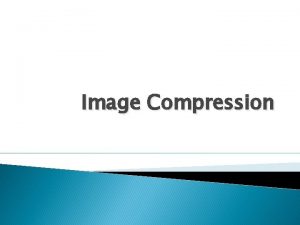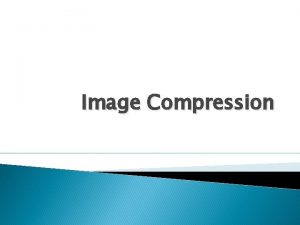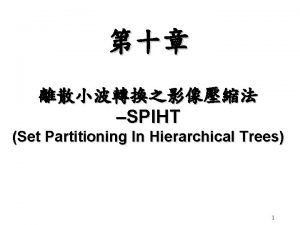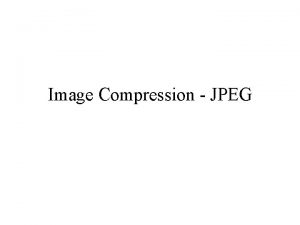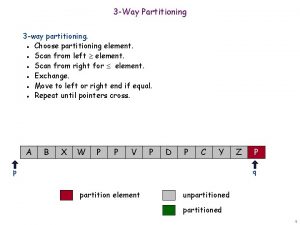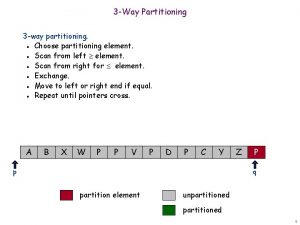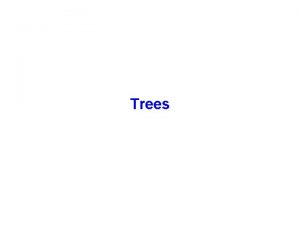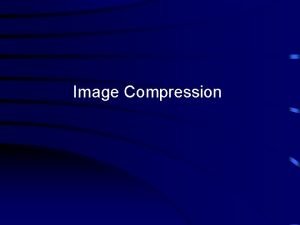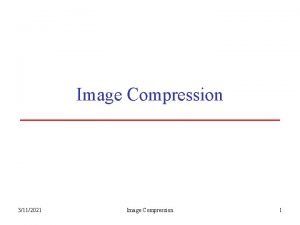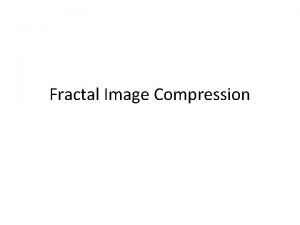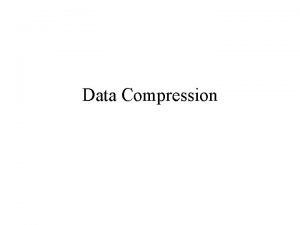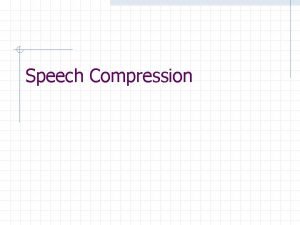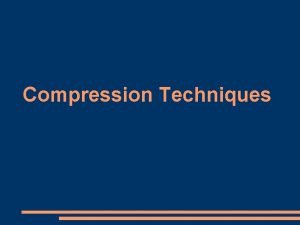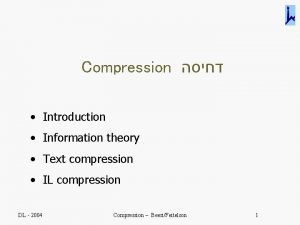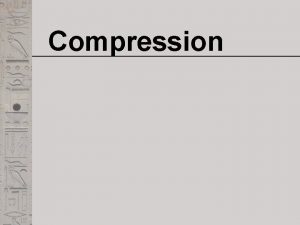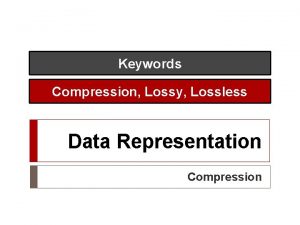Image Compression with Set Partitioning in Hierarchical Trees
































- Slides: 32

Image Compression with Set Partitioning in Hierarchical Trees (SPIHT) 王隆仁 1

References : (1) “A new fast and efficient image codec based on set partitioning in hierarchical trees, ” by Amir Said and William A. Pearlman, IEEE Transaction on Circuits and Systems for Video Technology, vol. 6, pp. 243 -250, June 1996. (2) “Comparison of different image subband coding methods at low bit rates, ” by Weixing Zhang and Thomas R. Fischer, IEEE Transaction on Circuits and Systems for Video Technology, vol. 9, pp. 419 -423, April 1999. (3) “Quantization performance in SPIHT and related wavelet image compression algorithm, ” by Brian A. Banister and Thomas R. Fischer, IEEE Signal Processing Letters, vol. 6, pp. 97 -99, May 1999. (4) http: //www. cipr. rpi. edu/research/SPIHT 2

Abstract o Embedded zerotree wavelet (EZW) coding, introduced by J. M. Shapiro, is a very effective and computationally simple technique for image compression. o Set partitioning in hierarchical trees (SPIHT), presented by A. Said and W. A. Pearlman, offers an alternative explanation of the principles of its operation, so that the reasons for its excellent performance can be better understood. o These principles are partial ordering by magnitude with a set partitioning sorting algorithm, ordered bit plane transmission, and exploitation of selfsimilarity across different scales of an image wavelet transform. o SPIHT provides a better performance than EZW. 3

1. INTRODUCTION o The image coding technique called embedded zerotree wavelet (EZW) interrupts the simultaneous progression of efficiency and complexity. o The EZW algorithm is a relatively simple technique that is based on the wavelet transform, followed by the successful prediction of insignificant coefficients across scales due to the self-similarity inherent in transformed images. o This technique not only was competitive in performance with the most complex techniques, but was extremely fast in execution and produced an embedded bit stream. o With an embedded bit stream, the reception of code bits can be stopped at any point and the image can be decompressed and reconstructed. 4

o The SPIHT technique is based on three concepts: 1) partial ordering of the transformed image elements by magnitude, with transmission of order by a subset partitioning algorithm that is duplicated at the decoder, 2) ordered bit plane transmission of refinement bits, 3) exploitation of the self-similarity of the image wavelet transform across different scales. o The partial ordering is a result of comparison of transform element (coefficient) magnitudes to a set of octavely decreasing thresholds. o We say that an element is significant or insignificant with respect to a given threshold, depending on whether of not it exceeds that threshold. o The crucial parts of coding process is that the way subsets of coefficients are partitioned and how the significance information is conveyed. 5

o SPIHT deserves special attention because it provides the following: ◆ good image quality, high PSNR; ◆ it is optimized for progressive image transmission; ◆ produces a fully embedded coded file; ◆ simple quantization algorithm; ◆ fast coding/decoding (nearly symmetric); ◆ has wide applications, completely adaptive; ◆ can be used for lossless compression; ◆ can code to exact bit rate or distortion; ◆ efficient combination with error protection. 6

2. PROGRESSIVE IMAGE TRANSMISSION o The coding is actually done to the array c = Ω(p) , where Ω(‧) represents a unitary hierarchical subband transformation and p is the original image. o In a progressive transmission scheme, the decoder initially sets the reconstruction vector d to zero and updates its components according to the coded message. o After receiving the value (approximate or exact) of some coefficients, the decoder can obtain a reconstructed image. r = Ω-1(d). 7

o A major objective in a progressive transmission scheme is to select the most important information -- which yields the largest distortion reduction -- to be transmitted first. o This means that the coefficients with larger magnitude should be transmitted first because they have a larger content of information. o Extending this approach, we can see that the information in the value of c can also be ranked according to its binary representation, and the most significant bits should be transmitted first. 8

3. TRANSMISSION OF THE COEFFICIENT VALUES o Fig. 1 shows the schematic binary representation of a list of magnitudeordered coefficients. Each column k in Fig. 1 contains the bits of cη(k). o The progressive transmission algorithm can be implemented as follows: o Algorithm I : 1) 2) output μn , followed by the pixel coordinates η(k) and sign of each of the μn coefficients such that 2 n≦ |cη(k)|≦ 2 n+1 (sorting pass); 3) output the nth most significant bit of all the coefficients with |ci, j|≧ 2 n+1 (i. e. , those that had their coordinates transmitted in previous sorting passes), in the same order used to send the coordinates (refinement pass); 4) decrement n by one , and go to Step 2). o The algorithm stops at the desired rate or distortion. 9

BIT ROW msb sign s s s s 5 1 1 0 0 0 4 1 1 0 0 0 0 0 3 1 1 0 0 0 2 1 1 1 1 lsb 0 Fig. 1. Binary representation of the magnitude-ordered coefficients. 10

4. SET PARTITIONING SORTING ALGORITHM o One of the main features of the proposed coding method is that the ordering data is not explicitly transmitted. o Instead, it is based on the fact that the execution path of any algorithm is defined by the results of the comparisons on its branching points. o So, if the encoder and decoder have the same sorting algorithm, then the decoder can duplicate the encoder’s execution path if it receives the results of the magnitude comparisons, and the ordering information can be recovered from the execution path. o One important fact used in the design of the sorting algorithm is that we do not need sort all coefficients. 11

o Actually, we need an algorithm that simply selects the coefficients such that 2 n ≦ |ci, j| ≦ 2 n+1, with n decremented in each pass. o Given n, if |ci, j| ≧ 2 n then we say that a coefficient is significant; otherwise it is called insignificant. o The sorting algorithm divides the set of pixels into partitioning subsets τm and performs the magnitude test o If the decoder receives a “no” to that answer(the subset is insignificant), then it knows that all coefficients in τm are insignificant. If the answer is “yes” (the subset is significant), then a certain rule shared by the encoder and the decoder is used to partition τm into new subsets τm, l and the significance test is then applied to the new subsets. This set division process continues until the magnitude test is done to all single coordinate significant subsets in order to identify each significant coefficient. 12

o To reduce the number of magnitude comparisons(message bits) we define a set partitioning rule that uses an expected ordering in the hierarchy defined by the subband pyramid. o The objective is to create new partitions such that subsets expected to be insignificant contain a large number of elements, and subsets expected to be significant contain only one element. o To make clear the relationship between magnitude comparisons and message bits, we use the function to indicate the significance of a set of coordinates τ. 13

5. SPATIAL ORIENTATION TREES o Normally, most of an image’s energy is concentrated in the low frequency components. o Consequently, the variance decreases as we move from the highest to the lowest levels of the subband pyramid. o Furthermore, it has been observed that there is a spatial self-similarity between subbands, and the coefficients are expected to be better magnitude-ordered if we move downward in the pyramid following the same spatial orientation. o A tree structure, called spatial orientation tree (SOT), naturally defines the spatial relationship on the hierarchical pyramid. o Fig. 2 shows how the SOT is defined in a pyramid constructed with recursive four-subband splitting. 14

★ Fig. 2. Examples of parent-offspring dependencies in the spatial-orientation tree. 15

o Each node of the tree corresponds to a pixel and is identified by the pixel coordinate. o Its direct descendants (offspring) correspond to the pixels of the same spatial orientation in the next finer level of the pyramid. o The tree is defined in such a way that each node has either no offspring (the leaves) of four offspring, which always form a group of 2 x 2 adjacent pixels. o In Fig. 2, the arrows are oriented from the parent node to its four offspring. o The pixels in the highest level of the pyramid are the tree roots and are also grouped in 2 x 2 adjacent pixels. o However, their offspring branching rule is different, and in each group, one of them (indicated by the star in Fig. 2 ) has no descendants. 16

o The following sets of coordinates are used to present the new coding method: O(i, j) : set of coordinates of all offspring of node (i, j); D(i, j) : set of coordinates of all descendants of the node (i, j); H : set of coordinates of all spatial orientation tree roots (nodes in the highest pyramid level); L(i, j) = D(i, j) - O(i, j). o The set partitioning rules are simply the following: ● The initial partition is formed with the sets {(i, j)} and D(i, j), for all (i, j) H. ● If D(i, j) is significant, then it is partitioned into L(i, j) plus the four single-element sets with (k, l) O(i, j). ● If L(i, j) is significant, then it is partitioned into the four sets D(i, j), with (k, l) O(i, j). 17

6. CODING ALGORITHM o Since the order in which the subsets are tested for significance is important, in a practical implementation the significance information is stored in three ordered lists, called list of insignificant sets (LIS), list of insignificant pixels (LIP), and list of significant pixels (LSP). o In all lists each entry is identified by a coordinate (i, j), which in the LIP and LSP represents individual pixels, and in the LIS represents either the set D(i, j) or L(i, j). o To differentiate between them, we say that a LIS entry is of type A if it represents D(i, j), and of type B if it represents L(i, j). o During the sorting pass (see Algorithm I), the pixels in the LIP-which were insignificant in the previous pass-are tested, and those that become significant are moved to the LSP. 18

o Similarly, sets are sequentially evaluated following the LIS order, and when a set is found to be significant it is removed from the list and partitioned. o The new subsets with more than one element are added back to the LIS, while the single-coordinate sets are added to the end of the LIP or the LSP, depending whether they are insignificant or significant, respectively. o The LSP contains the coordinates of the pixels that are visited in the refinement pass. o Below we present the new encoding algorithm in its entirety. It is essentially equal to Algorithm I, but uses the set partitioning approach in its sorting pass. 19

Algorithm II : 1) Initialization: set the LSP as an empty list, and add the coordinates (i, j)εH to the LIP, and only those with descendants also to the LIS, as type A entries. 2) Sorting Pass: 2. 1) for each entry (i, j) in the LIP do: 2. 1. 1) output Sn(i, j); 2. 1. 2) if Sn(i, j) = 1 then move (i, j) to the LSP and output the sign of ci, j; 2. 2) for each entry (i, j) in the LIS do: 2. 2. 1) if the entry is of type A then ● output Sn(D(i, j)); ● if Sn(D(i, j)) = 1 then * for each (k, l) O(i, j) do: ● output Sn(k, l); ● if Sn(k, l) = 1 then add (k, l) to the LSP and output the sign of ck, l; ● if Sn(k, l) = 0 then add (k, l) to the end of the LIP; 20

* if L(i, j) ≠ 0 then move (i, j) to the end of the LIS, as an entry of type B, and go to Step 2. 2. 2); otherwise, remove entry (i, j) from the LIS; 2. 2. 2) if the entry is of type B then ● output Sn(L(i, j)); ● if Sn(L(i, j)) = 1 then * add each (k, l) O(i, j) to the end of the LIS as an entry of type A; * remove (i, j) from the LIS. 3) Refinement Pass: for each entry (i, j) in the LSP, except those included in the last sorting pass (i. e. , with same n), output the nth most significant bit of |ci, j|; 4) Quantization-Step Update: decrement n by 1 and go to Step 2). o An example of Algorithm II is shown in Figs. 3 -9. 21

Fig. 3. Example of 3 -scale wavelet transform of an 8 by 8 image. 22

decoding 0) n=5 LSP←{} LIP ←{(63, -34, -31, 23)} LIS ←{(-34, -31, 23)} 1) n=5 (T=25=32) LSP←{(63, -34, 49, 47)} LIP ←{(-31, 23), (10, 14, -13), (15, 14, -9, -7), (-1, -3, 2)} LIS ←{(23), -34 B, (15, -9, -7)} output: 5, 1+1 -0011+0000100101+0000 Fig. 4. Example of an 8 by 8 image for SPIHT with Algorithm II. 23

2) n=4 (T=24=16) LSP←{(63, -34, 49, 47), (-31, 23)} LIP ←{(10, 14, -13), (15, 14, -9, -7), (-1, -3, 2)} LIS ←{(23), -34 B, (15, -9, -7)} decoding output: sorting pass: 4, 1 -1+00000000 refinement pass: 1010 Fig. 5. Example of an 8 by 8 image for SPIHT with Algorithm II. (continued) 24

3) n=3 (T=23=8) LSP←{(63, -34, 49, 47), (-31, 23), (10, 14, -13, 15, 14, -9, -12, -14, 8, 9, 11, 13, -12, 9)} LIP ←{(-7), (-1, -3, 2), (3), (-5, 3, 0), (2, -3, 5), (7, 3, 4), (7, 6, -1), (3, 3, 2)} LIS ←{(-7), 23 B, (14)} decoding output: sorting pass: 3, 1+1+1 -0000101 -1 -1+01 101+0010001+0101+0011 -0000 101+00 refinement pass: 100110 Fig. 6. Example of an 8 by 8 image for SPIHT with Algorithm II. (continued) 25

4) n=2 (T=22=4) LSP←{(63, -34, 49, 47), (-31, 23), (10, 14, -13, 15, 14, -9, -12, -14, 8, 9, 11, 13, -12, 9), (-7, -5, 5, 7, 4, 7, 6, 6, -4, 5, 6, 5, -7, 4, 4, 6, 6, -4, 4)} LIP ←{(-1, -3, 2), (3, 0), (2, -3), (-1), (3, 3, 2), (-2), (3, -2), (-2, 2, 0), (3, 0, 3), (3)} decoding LIS ←{} output: sorting pass: 2, 1 -00001+1+01+1+1+0000 11+1 -1+1+111+1 -1+011+1+00100 01+101+00101+1 -1+ refinement pass: 1001111011000110 Fig. 7. Example of an 8 by 8 image for SPIHT with Algorithm II. (continued) 26

5) n=1 (T=21=2) LSP←{(63, -34, 49, 47), (-31, 23), (10, 14, -13, 15, 14, -9, -12, -14, 8, 9, 11, 13, -12, 9), (-7, -5, 5, 7, 4, 7, 6, 6, -4, 5, 6, 5, -7, 4, 4, 6, 6, -4, 4), (-3, 2, 3, 3, 2, -3, 3, 2, -2, 3, -2, 2, 3, 3, 3)} LIP ←{(-1), (0), (0)} decoding LIS ←{} output: sorting pass: 1, 01 -1+1+1+01+1 -1+01+1+1+1 -1+ 1 -1 -1+01+01+1+ refinement pass: 110111110110010010 11100101100 Fig. 8. Example of an 8 by 8 image for SPIHT with Algorithm II. (continued) 27

6) n=0 (T=20=1) LSP←{(63, -34, 49, 47), (-31, 23), (10, 14, -13, 15, 14, -9, -12, -14, 8, 9, 11, 13, -12, 9), (-7, -5, 5, 7, 4, 7, 6, 6, -4, 5, 6, 5, -7, 4, 4, 6, 6, -4, 4), (-3, 2, 3, 3, 2, -3, 3, 2, -2, 3, -2, 2, 3, 3, 3), (-1, -1)} LIP ←{(0), (0)} decoding LIS ←{} output: sorting pass: 0, 1 -01 -00 refinement pass: 101111001101000111110 100010110000101101111 001000111 Fig. 9. Example of an 8 by 8 image for SPIHT with Algorithm II. (continued) 28

o One important characteristic of the algorithm is that the entries added to the end of the LIS in Step 2. 2) are evaluated before that same sorting pass ends. o So, when we say “for each entry in the LIS” we also mean those that are being added to its end. o With Algorithm II, the rate can be precisely controlled because the transmitted information is formed of single bits. o Note that in Algorithm II, all branching conditions based on the significance data Sn -- which can only be calculated with the knowledge of ci, j -- are output by the encoder. o Thus, to obtain the desired decoder’s algorithm, which duplicates the encoder’s execution path as it sorts the significant coefficients, we simply have to replace the words output by input in Algorithm II. 29

o But note that whenever the decoder inputs data, its three control lists (LIS, LIP, and LSP) are identical to the ones used by the encoder at the moment it outputs that data, which means that the decoder indeed recovers the ordering from the execution path. o It is easy to see that with this scheme, coding and decoding have the same computational complexity. o An additional task done by decoder is to update the reconstructed image. o As with any other coding method, the efficiency of Algorithm II can be improved by entropy-coding its output, but at the expense of a larger coding/decoding time. 30

7. SUMMARY AND CONCLUSIONS o The algorithm that operates through set partitioning in hierarchical trees (SPIHT) accomplishes completely embedded coding. o This SPIHT algorithm uses the principles of partial ordering by magnitude, set partitioning by significance of magnitudes with respect to a sequence of octavely decreasing thresholds, ordered bit plane transmission, and self-similarity across scale in an image wavelet transform. o The realization of these principles in matched coding and decoding algorithms is more effective than the implementations of EZW coding. o The authors feel that the results of this coding algorithm with its embedded code and fast execution are so impressive that it is a serious candidate for standardization in future image compression systems. (Fig. 10) 31

Fig. 10. Comparative evaluation of the new coding method. 32
 Set partitioning in hierarchical trees
Set partitioning in hierarchical trees Variable partition in os
Variable partition in os Arithmetic coding in digital image processing
Arithmetic coding in digital image processing Fidelity criteria in image compression
Fidelity criteria in image compression Total set awareness set consideration set
Total set awareness set consideration set Training set validation set test set
Training set validation set test set A set of nested clusters organized as a hierarchical tree
A set of nested clusters organized as a hierarchical tree Segmentation is the process of: *
Segmentation is the process of: * Quantization in data compression
Quantization in data compression Coding redundancy in image processing
Coding redundancy in image processing 472
472 Yuvpak compressed fractal image
Yuvpak compressed fractal image Jpeg still image data compression standard
Jpeg still image data compression standard Jpeg still image data compression standard
Jpeg still image data compression standard Singular value decomposition image compression
Singular value decomposition image compression Lossy compression in digital image processing
Lossy compression in digital image processing Signal image compression
Signal image compression Bounded set vs centered set
Bounded set vs centered set Fucntions
Fucntions Crisp set vs fuzzy set
Crisp set vs fuzzy set Crisp set vs fuzzy set
Crisp set vs fuzzy set What is the overlap of data set 1 and data set 2?
What is the overlap of data set 1 and data set 2? The function from set a to set b is
The function from set a to set b is Properties of vector
Properties of vector Partitioning numbers to 100
Partitioning numbers to 100 Fielder vector
Fielder vector Input space partitioning in software testing
Input space partitioning in software testing Channel partitioning mac protocols
Channel partitioning mac protocols European partitioning in africa answer key
European partitioning in africa answer key Partition a segment formula
Partition a segment formula Partitioning a segment formula
Partitioning a segment formula Empire partitioning across africa comprehension
Empire partitioning across africa comprehension 12.2 subdividing a segment in a given ratio answer key
12.2 subdividing a segment in a given ratio answer key
